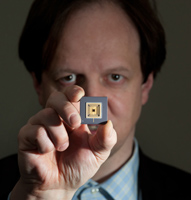A light-based wireless communication network developed by an Edinburgh-based mobile communications company could become a tool for government and business in case of terrorism and cyber crime.
pureLiFi says that its product offers a new and secure way of exchanging information over networks, using light rather than radio waves to communicate between devices.
Professor Harald Haas, its inventor and pureLifi Chief Scientific Officer, pictured, says: “Unlike existing wireless systems whose security vulnerabilities have received extensive media coverage in recent months, pureLiFi’s systems are almost impossible to intercept.”
Haas says that the new light-based communication technology, known as Li-Fi, could provide a way to enhance data security for any ‘high data risk’ industries.
By exploiting specific properties of light, the Li-Fi system prevents both sides of the communications link being intercepted. Professor Haas says: “Let us consider what Li-Fi means for the security of public and corporate internet access. Wi-Fi signals propagate in all directions and pass through walls and all data within range can be recorded. Because Li-Fi signals travel in directional beams between an access point and a terminal, and vice versa, a potential interceptor would need to be in the overlapping space of both light beams. Even an unencrypted Li-Fi access point provides better security than Wi-Fi.”
“Li-Fi removes the uncertainty of joining a network. In a typical Li-Fi installation, ceiling lights which transmit and receive the data are part of the premises and this creates a chain of accountability for the security of the users’ data. The inherent security advantages of Li-Fi and the accountability that it offers, provide a supplement to the emerging need for greater data security and responsibility.”
The company adds that Li-Fi is unlikely to replace Wi-Fi or 4G. It is intended to provide a complementary solution and an extra layer of data security and communications .
pureLiFi’s first product, Li-1st has been trialled within a number of organisations, with interested sectors including underwater communications, hazardous environments, telecoms, finance, aircraft manufacturing, and many more. “In fact, pureLiFi has recently undergone a second production run of the Li-1st system due to the high demand,” adds Haas.
Technical development in coming months will focus on higher data rates, reduced power consumption and miniaturisation. The mobile and networked product (Li-Flame) will be released in the second half of 2014.
The differences between Li-Fi and conventional Wi-Fi at a glance:
•Conventional Wi-Fi travels in all directions.
•Li-Fi travels in just one direction.
•Conventional Wi-Fi permeates structures including walls
•Li-Fi can only be accessed in rooms/buildings fitted with the necessary technology.
•Conventional Wi-Fi allows an attacker to hear both sides of a conversation
•In the unlikely event that an attacker intercepts the Li-Fi signal, he only ‘hears’ one side of the conversation.
Visit www.purelifi.com.










